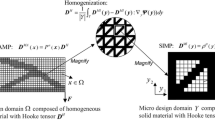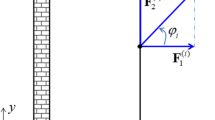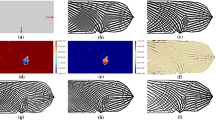Abstract
Gradient porous structured materials possess significant potential of being applied in many engineering fields. To accelerate the design process of infill graded microstructures of uniform local density, a novel asymptotic homogenisation topology optimisation method was proposed by Zhu et al. (J Mech Phys Solids 124:612–633, 2019), aiming for (1) significantly enriching the pool of representable graded microstructures; and (2) deriving an homogenised formulation for stress analysis in consistency with fine-scale results. But the work is severely confined from being widely applied, mainly due to the following two reasons. Firstly, to circumvent macroscopically pointwise computation for solving various microscopic cell problems, linearisation had to be adopted for its numerical implementation, and this significantly reduces the design freedom. Secondly, lacking of sensitive analysis, genetic algorithm was chosen for optimisation, inevitably decreasing the computational efficiency. To address these bottleneck challenging issues, a zoning scheme empowered by computational parallelism is introduced, and the sensitivity analysis associated with the new asymptotic framework is conducted. Through comparisons with fine-scale simulation results, the proposed algorithm is shown to be an effective tool for evaluating the mechanical behaviour of graded microstructures. As an optimisation tool, the mapping function takes a concise and explicit form. But its parameterisation still needs further investigation, so as to improve the solution optimality of the present approach, especially in comparison with another recently proposed method (Groen and Sigmund, Internat J Numer Methods Engrg 113(8):1148–1163, 2018). Optimisation results for three-dimensional graded microstructures are also shown, which are not frequently discussed in literature, possibly because of the high computational cost generated.



















Similar content being viewed by others
References
Aage N, Andreassen E, Lazarov BS, Sigmund O (2017) Giga-voxel computational morphogenesis for structural design. Nature 550(7674):84–86
Alexandersen J, Lazarov BS (2015) Topology optimisation of manufacturable microstructural details without length scale separation using a spectral coarse basis preconditioner. Comput Methods Appl Mech Engrg 290:156–182
Allaire G (2002) Shape optimization by the homogenization method
Allaire G, Geoffroy-Donders P, Pantz O (2019) Topology optimization of modulated and oriented periodic microstructures by the homogenization method. Comput Math Appli 78(7):2197–2229
Allaire G, Jouve F, Toader AM (2004) Structural optimization using sensitivity analysis and a level-set method. J Comp Phys 194(1):363–393
Arabnejad Khanoki S, Pasini D (2012) Multiscale design and multiobjective optimization of orthopedic hip implants with functionally graded cellular material. J Biomed Eng 134(3)
Avellaneda M (1987) Optimal bounds and microgeometries for elastic two-phase composites. SIAM J Appl Math 47(6):1216–1228
Bendsoe MP (1989) Optimal shape design as a material distribution problem. Struct Optim 1 (4):193–202
Bendsoe MP, Kikuchi N (1988) Generating optimal topologies in structural design using a homogenization method. Comput Methods Appl Mech Engrg 71(2):197–224
Bensoussan A, Lions JL, Papanicolaou G (1978) Asymptotic analysis for periodic structures. Studies in mathematics and its applications. North Holland Amsterdam
Cheng L, Bai JX, To AC (2019) Functionally graded lattice structure topology optimization for the design of additive manufactured components with stress constraints. Comput Methods Appl Mech Engrg 344:334–359
Cheng Z, Zhou HF, Lu QH, Gao HJ, Lu L (2018) Extra strengthening and work hardening in gradient nanotwinned metals. Science 362(6414):1925
Cioranescu D, Donato P (2010) An introduction to homogenization, Oxford Lecture Series in Mathematics, vol 17. Oxford University Press, Oxford
Coelho PG, Fernandes PR, Guedes JM, Rodrigues HC (2008) A hierarchical model for concurrent material and topology optimisation of three-dimensional structures. Struct Multidiscip Optim 35(2):107–115
Deng JD, Chen W (2017) Concurrent topology optimization of multiscale structures with multiple porous materials under random field loading uncertainty. Struct Multidiscip Optim 56(1):1–19
Deng JD, Yan J, Cheng GD (2013) Multi-objective concurrent topology optimization of thermoelastic structures composed of homogeneous porous material. Struct Multidiscip Optim 47(4):583–597
Dong HW, Zhao SD, Wang YS, Zhang CZ (2017) Topology optimization of anisotropic broadband double-negative elastic metamaterials. J Mech Phys Solids 105:54–80
Fratzl P, Barth GF (2009) Biomaterial systems for mechanosensing and actuation. Nature 462:442–448
Gao J, Li H, Gao L, Xiao M (2018) Topological shape optimization of 3D micro-structured materials using energy-based homogenization method. Adv Engrg Softw 116:89–102
Geoffroy-Donders P, Allaire G, Pantz O (2020) 3-D topology optimization of modulated and oriented periodic microstructures by the homogenization method. J Comp Phys 108994:401
Groen JP, Sigmund O (2018) Homogenization-based topology optimization for high-resolution manufacturable microstructures. Internat J Numer Methods Engrg 113(8):1148–1163
Groen JP, Stutz FC, Aage N, Barentzen JA, Sigmund O (2020) De-homogenization of optimal multi-scale 3D topologies. Comput Methods Appl Mech Eng 112979:364
Groen JP, Wu J, Sigmund O (2019) Homogenization-based stiffness optimization and projection of 2D coated structures with orthotropic infill. Comput Methods Appl Mech Engrg 349:722–742
Guo X, Zhang WS, Zhong WL (2014) Doing topology optimization explicitly and geometrically - a new moving morphable components based framework. ASME J Appl Mech 81(8):081009–1–081009-12
Jorgensen O, Giannakopoulos AE, Suresh S (1998) Spherical indentation of composite laminates with controlled gradients in elastic anisotropy. Int J Solids Struct 35(36):5097–5113
Kushwaha MS, Halevi P, Dobrzynski L, Djafari-Rouhani B (1993) Acoustic band structure of periodic elastic composites. Phys Rev Lett 71(13):2022–2025
Lakes R (1993) Materials with structural hierarchy. Nature 361(6412):511–515
Liu C, Du ZL, Sun Z, Gao HJ, Guo X (2015) Frequency-preserved acoustic diode model with high forward-power-transmission rate. Phys Rev Appl 3(6):064014
Liu C, Du ZL, Zhang WS, Zhu YC, Guo X (2017) Additive manufacturing-oriented design of graded lattice structures through explicit topology optimization. ASME J Appl Mech 84(8):081008–1–081008-12
Liu L, Yan J, Cheng GD (2008) Optimum structure with homogeneous optimum truss-like material. Comput Struct 86(13):1417– 1425
Liu ST, Cheng GD, Gu Y, Zheng XG (2002) Mapping method for sensitivity analysis of composite material property. Struct Multidiscip Optim 24(3):212–217
Meyers MA, McKittrick1 J, Chen PY (2013) Structural biological materials: critical mechanics-materials connections. Science 339(6121):773–779
Milton GW (1986) Modelling the properties of composites by laminate. Springer, New York, pp 150–174
Niu B, Yan J, Cheng GD (2009) Optimum structure with homogeneous optimum cellular material for maximum fundamental frequency. Struct Multidiscip Optim 39(2):115–132
Pantz O, Trabelsi K (2008) A post-treatment of the homogenization method for shape optimization. SIAM J Control Optim 47(3):1380–1398
Radman A, Huang X, Xie YM (2013) Topology optimization of functionally graded cellular materials. J Mater Sci 48(4):1503–1510
Radman A, Huang X, Xie YM (2014) Maximizing stiffness of functionally graded materials with prescribed variation of thermal conductivity. Comp Mater Sci 82:457–463
Rodrigues H, Guedes JM, Bendsoe MP (2002) Hierarchical optimization of material and structure. Struct Multidiscip Optim 24(1):1–10
Sanchez C, Arribart H, Guille MMG (2005) Biomimetism and bioinspiration as tools for the design of innovative materials and systems. Nat Mater 4:277–288
Sigmund O (1994) Materials with prescribed constitutive parameters: an inverse homogenization problem. Int J Solids Struct 31(17):2313–2329
Sigmund O, Torquato S (1996) Composites with extremal thermal expansion coefficients. Appl Phys Lett 69(21):3203–3205
Svanberg K (1987) The method of moving asymptotes–a new method for structural optimization. Internat J Numer Methods Engrg 24:359–373
Vogiatzis P, Ma M, Chen SK, Gu XFD (2018) Computational design and additive manufacturing of periodic conformal metasurfaces by synthesizing topology optimization with conformal mapping. Comput Methods Appl Mech Engrg 328:477–497
Wang MY, Wang XM, Guo DM (2003) A level set method for structural topology optimization. Comput Methods Appl Mech Engrg 192(1):227–246
Wang YQ, Chen FF, Wang MY (2017) Concurrent design with connectable graded microstructures. Comput Methods Appl Mech Engrg 317:84–101
Wu J, Wang WM, Gao XF (2019) Design and optimization of conforming lattice structures. IEEE Trans Vis Comput Graph 1–1
Xue DC, Zhu YC, Guo X (2020) Generation of smoothly-varying infill configurations from a continuous menu of cell patterns and the asymptotic analysis of its mechanical behaviour. Comput Methods Appl Mech Engrg 113037:366
Yan J, Guo X, Cheng GD (2016) Multi-scale concurrent material and structural design under mechanical and thermal loads. Comput Mech 57(3):437–446
Zhang WS, Yang WY, Zhou JH, Li D., Guo X (2016) Structural topologyoptimization through explicit boundary evolution. ASME J Appl Mech 84(1):011011–1–011011-10
Zhang WS, Yuan J, Zhang J, Guo X (2016) A new topology optimization approach based on moving morphable components (mmc) and the ersatz material model. Struct Multidiscip Optim 53(6):1243–1260
Zhang Y, Li H, Xiao M, Gao L, Chu S, Zhang JH (2019) Concurrent topology optimization for cellular structures with nonuniform microstructures based on the kriging metamodel. Struct Multidiscip O 59(4):1273–1299
Zhang Y, Xiao M, Li H, Gao L, Chu S (2018) Multiscale concurrent topology optimization for cellular structures with multiple microstructures based on ordered SIMP interpolation. Comp Mater Sci 155:74–91
Zhou M, Rozvany GIN (1991) The COC algorithm, part II: topological, geometrical and generalized shape optimization. Comput Methods Appl Mech Engrg 89(1):309–336
Zhou SW, Li Q (2008) Design of graded two-phase microstructures for tailored elasticity gradients. J Mater Sci 43(15):5157
Zhu YC, Li SS, Du ZL, Liu C, Guo X, Zhang WS (2019) A novel asymptotic-analysis-based homogenisation approach towards fast design of infill graded microstructures. J Mech Phys Solids 124:612–633
Acknowledgements
We thank Ole Sigmund and Jeroen Groen for providing the comparative simulation example shown in Fig. 12. We also thank Ole Sigmund for many valuable comments, without which the article cannot reach the present stage. The comments from (anonymous) reviewers during the previous rounds of review process are also appreciated.
Funding
This study was financially supported by the National Key Research and Development Plan (2016YFB0201601) from the Ministry of Science and Technology of the People’s Republic of China, the National Natural Science Foundation of China (11772076, 11732004, 11821202), the Fundamental Research Funds for the Central Universities (DUT16RC(3)091), and Program for Chang-jiang Scholars, Innovative Research Team in University (PCSIRT).
Author information
Authors and Affiliations
Corresponding authors
Ethics declarations
Conflict of interest
The authors declare that they have no conflict of interest.
Additional information
Responsible Editor: Somanath Nagendra
Publisher’s note
Springer Nature remains neutral with regard to jurisdictional claims in published maps and institutional affiliations.
Replication of results
All the data underlying the argument in the article are generated by locally devised MATLAB codes consisting of a set of systematically arranged sub-function modules (such as homogenisation). We are willing to satisfy the reasonable and responsible demand for the data and the source codes underpinning the present article.
Rights and permissions
About this article
Cite this article
Xue, D., Zhu, Y., Li, S. et al. On speeding up an asymptotic-analysis-based homogenisation scheme for designing gradient porous structured materials using a zoning strategy. Struct Multidisc Optim 62, 457–473 (2020). https://doi.org/10.1007/s00158-020-02655-8
Received:
Revised:
Accepted:
Published:
Issue Date:
DOI: https://doi.org/10.1007/s00158-020-02655-8




